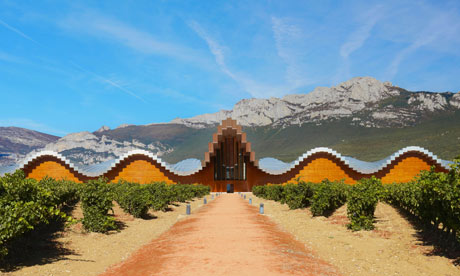He is the genius behind some of the world's most spectacular bridges, museums and airports, but Spanish architect Santiago Calatrava cannot plug a leaking roof, according to a client who is demanding he contribute to the €2m (£1.7m) needed to pay someone else to do the job. A dozen years after Calatrava built the spectacular Ysios winery in the rainy Alava region of northern Spain, the building's dramatic, undulating roof continues to let in the damp.
Now Domecq, the owner of the winery, has said it is fed up with the botched attempts of Calatrava's original builders at fixing the roof and wants money from them so that it can bring in fresh architects and engineers to design a new one.
An expert's report that accompanies a writ lodged at a court in Vitoria claims that the roof, made of wood and aluminium, has never managed to keep the rain out. The firm pledges to maintain the original outline designed by Calatrava – an architect and engineer sometimes compared with fellow Spaniard Antoni Gaudí – but says that the leaks are damaging its image.
The row comes on the top of complaints in Calatrava's home city of Valencia about the slowly wrinkling, ceramic outer skin of the city's emblematic Palau de Les Arts, where tiles have started to shake loose.
Opposition politicians in Valencia claim that the overall budget for his spaceship-like arts and science complex in the city has quadrupled to €1bn – with almost €100m for the architect's firm. They have demanded that Zurich-based Calatrava, who responded that "his honour was wounded", give some of the money back.
"It has not just put Valencia on the map, but is the second-most visited cultural centre in Spain, after the Alhambra," the architect once declared.
He is also on record as saying that his fees for various projects in the city were perfectly reasonable.
Yet another row, this time with Italian authorities, has seen doubts raised about the cost of his bridge over the Grand Canal in Venice – the first bridge to be built there in 75 years. Authorities now demand that he and others involved cover some €4m of spending, while Il Giornale newspaper recently claimed the city had received some 5,000 complaints from those who have used it, including some who also claim it is too slippery.
In northern Bilbao, meanwhile, his Zubizuri bridge over the river Nervión has been dubbed the "wipe-out" bridge, because of the number of people who have slipped and fallen. Authorities there have also reportedly had to spend up to €6,000 a year replacing broken tiles.
The mayor of Bilbao, Iñaki Azkuna, who lost a case against him after authorities altered the original design of his bridge, once declared: "I'm fed up with the dictatorship of Calatrava." In Oviedo a court has ordered that the architect and construction firms involved in building a conference hall there should pay €3m to the insurance firm after part of the structure collapsed during building.
The Oviedo hall's infamous, huge mechanical visor has never worked because of problems with its hydraulics. Calatrava is currently battling the building's owners through the courts after they blamed him and refused to pay his full fees.
But for every Calatrava building that gets into trouble, there are several that survive without creating polemic. They include two bridges in Dublin and Manchester, railway stations in Lisbon, Liege and Lyon and buildings in New York and Milwaukee.
Calatrava did not respond to questions sent to his Zurich office.
Related Stories
| Nov 11, 2011
By the Numbers
What do ‘46.9,’ ‘886.2,’ and ‘171,271’ mean to you? Check here for the answer.
| Nov 11, 2011
Streamline Design-build with BIM
How construction manager Barton Malow utilized BIM and design-build to deliver a quick turnaround for Georgia Tech’s new practice facility.
| Nov 11, 2011
AIA: Engineered Brick + Masonry for Commercial Buildings
Earn 1.0 AIA/CES learning units by studying this article and successfully completing the online exam.
| Nov 11, 2011
How Your Firm Can Win Federal + Military Projects
The civilian and military branches of the federal government are looking for innovative, smart-thinking AEC firms to design and construct their capital projects. Our sources give you the inside story.
| Nov 10, 2011
BD+C's 28th Annual Reconstruction Awards
A total of 13 projects recognized as part of BD+C's 28th Annual Reconstruction Awards.
| Nov 10, 2011
Grousbeck Center for Students & Technology opens doors
New Perkins School for the Blind Building is dedicated to innovation, interaction, and independence for students.
| Nov 10, 2011
Skanska Moss to expand and renovate Greenville-Spartanburg International Airport
The multi-phase terminal improvement program consists of an overall expansion to the airport’s footprint and major renovations to the existing airport terminal.
| Nov 10, 2011
Suffolk Construction awarded MBTA transit facility and streetscape project
The 21,000-sf project will feature construction of a cable-stayed pedestrian bridge over Ocean Avenue, an elevated plaza deck above Wonderland MBTA Station, a central plaza, and an at-grade pedestrian crossing over Revere Beach Boulevard
| Nov 10, 2011
Thornton Tomasetti’s Joseph and Choi to co-chair the Council on Tall Buildings and Urban Habitat’s Outrigger Design Working Group
Design guide will describe in detail the application of outriggers within the lateral load resisting systems of tall buildings, effects on building behavior and recommendations for design.



















